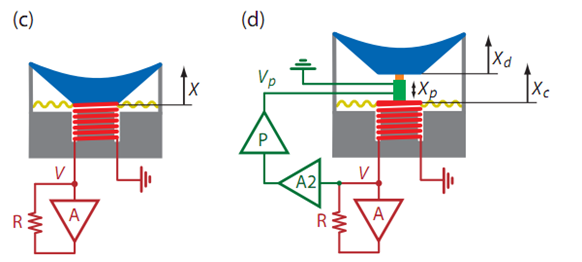Neuroscientists Reinvent Microphone Based On Mammalian Hearing System
A microphone is a device that converts mechanical waves into electrical ones. It consists of a diaphragm attached to a coil which sits in a magnetic field. When a sound wave hits the diaphragm, it moves the coil, generating a current. This signal is then amplified by conventional electronic methods.

But an interesting question is why the amplification has to be done electronically. Why not mechanically?
The conventional explanation is the Maxwell-Betti reciprocity theorem. It states that if a force applied at a point A produces a displacement at a point B then the same force at B causes an equal displacement at A.
It means that in a mechanical amplifier, the output will always be directly coupled to the input and vice versa. So any feedback will amplify noise as much as the signal of interest.
And therein lies the problem. In a microphone, for example, you could amplify the movement of the coil be feeding the amplified electrical signal back to the coil, which then generates a bigger signal and so on. But this would very rapidly spiral out of control causing the well known explosion of noise that sound engineers call feedback..
By contrast, electronic components are not bound by this reciprocity. Reverse the voltage across a diode, for example, and you’ll find a very different current flowing. This leads to a different type of amplification in which the input controls the output but the output does not feedback to the input.
That’s a significant difference. It’s fair to say that so-called unidirectional amplifiers have had a profound impact on our society.
Today, Tobias Reichenbach and James Hudspeth at The Rockefeller University in New York say they’ve worked out how to get around the problem of reciprocity in mechanical amplifiers. And they’ve used their approach to build a microphone that amplifies sound mechanically.
Their device is relatively straightforward. It is similar to an ordinary microphone except that the diaphragm is connected to the coil by a piezoelectric element, which can change its length according to the voltage applied across it.
So the trick behind amplifying the movement of the coil in a controlled way is to send the amplified electrical signal back to the coil but also to the piezoelectric element via a phase shifter.
At certain frequencies, the phase shift will dampen the feedback entirely. But they key point is that at a certain resonant frequency, the microphone becomes hugely sensitive. In fact, at this frequency, the unidirectional amplification actually lowers the threshold at which signals can be detected.
Detecting a range of frequencies requires an array of microphones tuned to different wavelengths and provides efficient amplification with almost no distortion due to unwanted feedback.
This is not an entirely new idea. Reichenbach and Hudspeth say they took their inspiration from their recent work on the mammalian inner ear, which seems to employ just this kind of piezoelectric feedback in auditory hair cells.
With that kind of pedigree, engineers will be wanting to try out the idea in other areas. So if you’re studying sonar, sound waves, seismic waves or even gravitational waves, give it a try.
Ref: arxiv.org/abs/1104.2871: Unidirectional Mechanical Amplifification As A Design Principle For An Active Microphone
You can now follow The Physics arXiv Blog on Twitter
Keep Reading
Most Popular
Large language models can do jaw-dropping things. But nobody knows exactly why.
And that's a problem. Figuring it out is one of the biggest scientific puzzles of our time and a crucial step towards controlling more powerful future models.
How scientists traced a mysterious covid case back to six toilets
When wastewater surveillance turns into a hunt for a single infected individual, the ethics get tricky.
The problem with plug-in hybrids? Their drivers.
Plug-in hybrids are often sold as a transition to EVs, but new data from Europe shows we’re still underestimating the emissions they produce.
Stay connected
Get the latest updates from
MIT Technology Review
Discover special offers, top stories, upcoming events, and more.